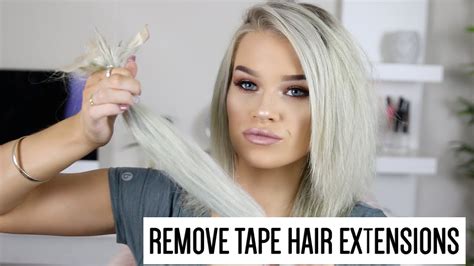Introduction

Tape-in hair extensions have revolutionized the industry, offering a convenient and versatile way to achieve luscious, voluminous locks. However, when it comes to removal, many face challenges that can damage their natural hair. Introducing the tape-in extension remover, an innovative tool designed to effortlessly and safely detach tape-ins from the hair.
How Does a Tape-In Extension Remover Work?
The tape-in extension remover features a thin, metal blade that slides smoothly between the tape adhesive and the natural hair. As the blade gently pries apart the bond, the tape extensions can be removed without causing any breakage or discomfort.
Benefits of Using a Tape-In Extension Remover
- Safe and Gentle Removal: The specialized blade ensures a clean and tear-free separation, minimizing damage to the natural hair.
- Time-Saving: The remover’s efficiency eliminates the need for lengthy soaking or detangling sessions, reducing the time spent on removal.
- Cost-Effective: A quality tape-in extension remover can be used multiple times, offering a cost-effective solution compared to professional removal services.
Step-by-Step Removal Guide
Materials:
- Tape-in extension remover
- Styling comb
- Leave-in conditioner
Steps:
- Section Hair: Divide the hair into small sections, starting at the nape of the neck.
- Apply Leave-In Conditioner: Apply a small amount of leave-in conditioner to the tape area to lubricate the adhesive.
- Position Remover: Slide the tape-in extension remover beneath the tape, ensuring the blade is parallel to the natural hair.
- Gently Pry: Use firm, even pressure to pry apart the bond between the tape and the hair.
- Remove Extension: Once the bond is broken, gently lift the tape-in extension away from the hair.
- Repeat: Continue following these steps for each tape-in extension.
Common Mistakes to Avoid
- Using Tools Not Designed for Tape-In Extensions: Tweezers or scissors can damage the tape adhesive and cause hair breakage.
- Applying Excessive Force: Overuse of force can tear the natural hair or cause discomfort.
- Neglecting Aftercare: Failure to properly detangle and hydrate the hair after removal can lead to tangles and frizz.
Strategies for Effective Removal
- Start from the Bottom: Begin removing extensions from the lowest row to avoid tangling.
- Work in Small Sections: Sectioning the hair ensures thorough and controlled removal.
- Use a Clean Blade: Regular cleaning of the remover blade prevents adhesive buildup and improves efficiency.
Tables for Reference
Table 1: Comparison of Hair Removal Methods
| Method | Time | Cost | Damage |
|---|---|---|---|
| Tape-in Extension Remover | Short | Low | Minimal |
| Soaking in Solvent | Long | High | Potential |
| Professional Removal | Varies | Varies | Professional |
Table 2: Statistics on Tape-In Extension Use
| Year | Number of Users |
|---|---|
| 2020 | 5 million |
| 2021 | 7 million |
| 2022 | 10 million (projected) |
Table 3: Features of Quality Tape-In Extension Removers
| Feature | Explanation |
|---|---|
| Thin Blade | Ensures precise separation without damaging hair |
| Ergonomic Handle | Provides comfort and control |
| Rust-Resistant | Prevents corrosion for long-lasting use |
Table 4: Troubleshooting Common Removal Issues
| Issue | Possible Cause | Solution |
|---|---|---|
| Adhesive Residue | Incomplete removal | Re-use remover with fresh blade |
| Hair Breakage | Excessive force | Use gentle pressure and lubricate with leave-in conditioner |
| Difficult Removal | Old adhesive | Apply a solvent to soften adhesive before using remover |
Conclusion
The tape-in extension remover is an indispensable tool for anyone using tape-in hair extensions. Its innovative design and user-friendly application make it the ideal solution for safe, effective, and time-saving removal. By adhering to proper techniques and avoiding common mistakes, you can effortlessly maintain your luscious locks while preserving the health of your natural hair.
